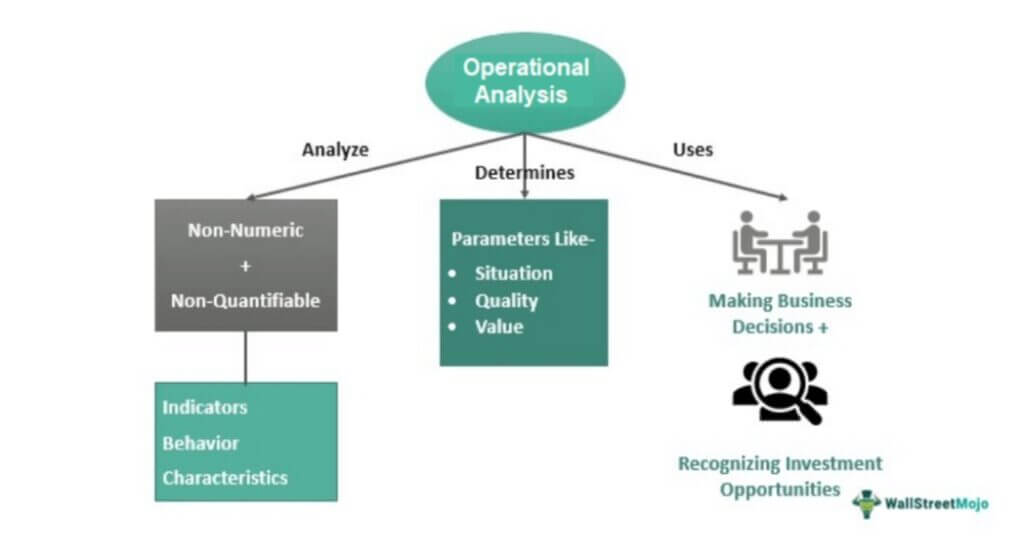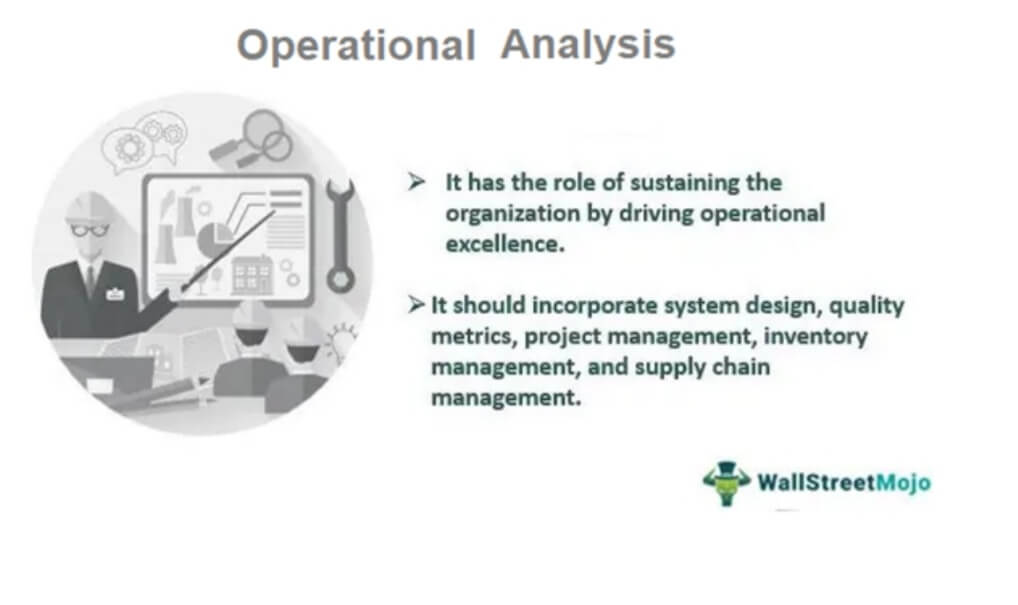Table Of Contents
What is Operational Analysis?
An operational analysis compares current business performance with historical data to review business operations. The analysis focuses on consistency and costs incurred by a company. Upon completion, the analysis highlights errors and suggests measures to overcome them.

Operation analysis is mostly employed by startups to evaluate potential flaws, loopholes, and the overall feasibility of the idea. It is also a significant part of a business self-assessment. The analysis studies the management of resources and day-to-day operations. Operational analysts inspect a firm’s financial investments and financial statements.
Key Takeaways
- Operational analyses compare current business performance with past performance. The analysis focuses on business operations, financial standing, and quality control.
- Using this analysis, companies cut down costs, pinpoint room for improvement, and improve decision-making.
- In addition to businesses, this method is followed by teams, task forces, and organizations to understand organizational frameworks and systems.
- Operation analysis also focuses on customer satisfaction—ascertaining whether customer needs are met.
- It suggests operational improvements by which firms can better fulfill customer expectations.
Operational Analysis Explained
The business operational analysis comprises operational analysis techniques and self-assessment techniques that look at business processes and performance. This approach compares past business performance with current business performance.

To analyze business operations, analysts first need to define an objective. Every firm sets certain parameters for sales and economic growth. Keeping those in mind, operational analysts create a structure and process that can track a firm's progress.
Simply put, companies perform internal audits to gauge the efficiency of business operations. Further, this involves the analysis of the firm's structural framework, SOP, financial investments, cost cutting, productivity, and the quality of finished products. Operational analysts also review the firm's maintenance, quality control, and consistency.
The main objective of the operational analysis is to seek continuous improvement in the organization's operational structure. This way, productivity, and profitability can be increased. Based on the business operational analysis, unnecessary costs can be cut.
The application of operation analysis, though, is not just limited to business. This analysis is performed by various task forces and group structures as well. Navy SEALS and army task forces are good operational analysis examples. In military operations, analysis is used to gauge how the unit can become more efficient; the approach is used to simulate drills that closely replicate real-world scenarios.
The operational analysis definition highlights five important pillars:
- Understanding the organizational goal.
- Collection of reliable and relevant information.
- Analyzing large datasets.
- Developing insights and perspectives.
- Succinct presentation of observed strengths and loopholes.
The business operational analysis goes beyond research. After studying processes and formulating improvements, analysts also apply the necessary changes. Thus, businesses end up saving time, money, and workforce to increase profits.
Example
Now, let us look at an operational analysis example to understand how it works.
Julia wants to open a salon; she possesses the required capital and funds. But before jumping in, she performs an operation analysis. It is part of a self-assessment endeavor—she makes a note of all possible threats and risks associated with her enterprise.
She runs through multiple scenarios—from buying a place to renting it, from hiring hair artists to a massage therapist, and from pricing to home delivery. The simple analysis helps Julia understand where she can make the right investments and components that can be postponed. She also studies existing salons in the vicinity and compares their rates—for various services. Based on market research, she settles on a fixed rate for services rendered by her salon.
Two years down the line, Julia once again wants to perform an operation analysis. She wants to compare her present condition to where she started. She specifically zeroes in on profits and opportunities to maximize profits. She researches historical data—books of accounts and salon records. She studies profits and expenses during the two-year period and compares them with her current earnings.
She identifies certain areas that exhibit room for improvement. Sales figures pertaining to body care products and services have declined. Holding stock for those products costs a lot. Therefore, Julia removes those products. Eventually, this led to a 9% hike in net profits.
Julia took advantage of operation analysis techniques to understand the feasibility of various business operations. By cutting down unnecessary costs, she could increase operational efficiency and maximize profitability.
Importance
- It is a significant part of self-assessment for businesses. By performing operation analysis, businesses can gauge where they stand currently. The analysis sheds light on businesses' financial health.
- Based on the analysis, business owners make better decisions. The analysis specifically focuses on predefined goals and objectives.
- The analysis cuts down unnecessary costs—ultimately increasing profits.
- In a competitive market, operation analysis gives an edge over a business rival by using tools like cost advantage and market investment share.
- When a company runs an operation analysis, they try to upgrade its products, services, and customer satisfaction.
- It gives employees a new perspective on day-to-day operations. It increases employee engagement, builds teamwork, instills a problem-solving attitude, and advocates critical thinking.
- Operation analysis is based on historical data—it streamlines data and documents. This, in turn, can be used as a roadmap for the future—identifying patterns, flaws, errors, and strengths.
- An operation analysis must be performed before starting a project as it reviews the feasibility of operations. It also pinpoints foreseeable drawbacks (that can be encountered in the initial stages of the business idea).
